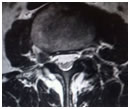 |
|
  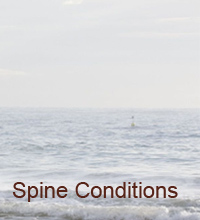 |
|
| Home » Services » Spine Conditions | ||||
Disc Disease
Probably the most commonly affected structure that neurosurgeons treat. Acute disc prolapse, bulging disc, herniated disc, or ruptured disc are all terms commonly used to describe failures of this structure. When the symptoms are new, the typical sequence is back pain in the region of the disc followed by nerve irritation pain down the arm or leg. This is called radicular pain, and some people use the term sciatica when the leg is affected. A long standing disc prolapse may present with chronic back, neck, arm, shoulder or leg pain, in any combination. All three parts of the mobile spinal column can be affected, but the lumbar and cervical regions are far more likely to cause symptoms. This is because of the relative mobility and loads placed on these regions. The symptoms cause pain which is typically worse on loading and relieved by rest or flexed positions. Arm or leg pain is very common and when more severe there may be numbness or weakness of a limb or hand dysfunction. The distribution of the pain or neurological symptoms is determined by the nerve affected and is dependent on whether the disc is cervical, thoracic or lumbar in origin. When there is spinal cord compression, walking, balance and continence can be affected. Surgery is indicated if there is a significant neurological problem or if the pain is not responding well to simple measures. Simple discectomy, microdiscectomy, minimally invasive discectomy or anterior cervical discectomy and fusion may be highly effective in selected patients not responding to rest, analgesia and other conservative measures. Nerve Pain
Back PainAlthough very common, back pain can be caused by a large number of conditions and it may not always be possible to clarify the cause with absolute certainty. The intervertebral discs, vertebral bodies and facet joints are all common sources of back pain. When conservative treatment is failing, then surgical intervention may be considered in cases where the source of pain can be confidently identified. Additional testing (e.g. discography) is sometimes required to establish which patients will benefit from intervention. Facet Joint DiseaseThe facet joints are an important component of the spine ensuring stability and allowing a safe range of movement. When disease affects these joints, there is usually enlargement of the joint and fluid build up and this often leads to narrowing of the spinal canal and compression of the underlying nerves. Synovial cysts may occur under the joint. There may be referred pain from the joint. Facet injections may have a role when there is isolated pain in relation to this. Common surgical treatments include resection of cysts, a facetectomy, laminectomy or fusion procedure. Instability and DeformityAbnormal alignment or angulation of the spine may cause disabling symptoms. The most common form of this is a result of wear and tear changes affecting the intervertebral discs and the overlying facet joints. This can lead to movement or displacement of one vertebra relative to its neighbour, called spondylolisthesis. A congenital form of this is also seen in the lumbar spine and results from a defect in the bridging bone called the "pars". When symptomatic or progressive, a decompression or fusion procedure can be very effective. Most typically, an instrumented fusion would be recommended in these cases. TraumaSpinal injury is a very common cause of back and neck pain. This may range from major trauma to minor whiplash injuries or even sudden positional changes. Bony fractures or crush injuries, facet injury, ligamentous or disc rupture may be the result. The starting point is to define the injury, mechanism and structures involved as accurately as possible. However, it may not always be possible to clearly define the cause of the pain, such as in some cases of whiplash injuries. Stable injuries can be treated with rest and immobilization with special collars and braces and are followed with serial imaging. Instable injuries require surgery. Commonly used surgical strategies include ADCF, corpectomy, instrumented fusions and lateral mass fusions. Spine TumoursTumours can affect the spinal column or vertebrae, as well as the contents of the spinal canal; the spinal cord, nerve roots and epidural tissues. The most common tumour causing symptoms is cancer in the form of metastatic deposits. These tumours may present with pain from nerve compression or fracture or with spinal cord/nerve dysfunction. Primary bony tumours of the spine, such as chordoma, sarcoma or chondrosarcoma are much less common. Some combination of surgery and radiation is often required for treatment. Haemangiomas are common benign tumours of the spinal column. They are on occasions symptomatic and if so may also be considered for treatment. Other tumours arise from the coverings of the spinal cord or from within its substance. Meningioma, schwannoma, Neurofibroma, Astrocytoma, Ependymoma are the most common types. Surgery is usually required to establish a diagnosis, to remove pressure effects from the spinal cord and nerve roots, and sometimes to provide stability. The tumours can be subclassified according to location and the structure of origin as intradural, extradural , intrinsic or extrinsic. Spine SurgeryMicrodiscectomy / Foramenotomy Spinal nerves become symptomatic and produce pain when they are compressed. Most commonly, a disc prolapse will push the nerve against an overlying bony structure. A microdiscectomy describes the procedure where the offending small portion of the prolapsed disc is removed using magnification and a unilateral (one sided) approach. The foramen refers to the tunnel through which the spinal nerves exit the spinal canal. When the nerve is compressed here, part of the tunnel is opened up to relieve the nerve. This is called a "foramenotomy".
Laminectomy / Hemilaminectomy The lamina are part of the posterior ring structure of every vertebra that surrounds the spinal cord and central neural structures. A laminectomy removes part of this ring to allow access to compressed structures beneath. When there is canal stenosis, this alone is usually sufficient to treat the symptoms. When the symptoms are on one side, the surgery can be minimalized even further by taking off only part of this posterior ring, the "hemi-lamina". Indirect access to the contralateral (opposite) side can also be achieved. Minimally Invasive Surgery This term refers to a new way of performing spinal surgery, with the help of tubular systems of retractors rather than through an open incision. It is designed to minimise muscle trauma and to shorten post-operative recovery times. The trade off in my view can be with exposure and safety. The technique should be used on a selective basis at this time. MIS case of lumbar spine
Motion Preserving Surgery Every segment of the spinal column permits a small amount of motion through the intervertebral disc and the facet joints. This allows for flexion and extension, lateral flexion, and some rotation. These movements, when combined over many segments, allow for all of our usual daily activities to be performed. Whenever possible, simple procedures are preferred over fusion operations to preserve this motion. However, if the primary problem is with the disc or with abnormal motion, then a fusion may well be the most appropriate intervention. Instrumented Fusion
Extraforamenal Discs / Far Lateral Discs Occasionally, a disc prolapse will be outside the normal spinal canal and affect the course of the nerve in this location. The nerve is highly sensitive at this point in its course and for patients with severe or refractory symptoms, surgery can be highly effective. A special approach is used to correct the problem.
|
 |
© Dr Jonathan Curtis MBBS, FRACS, Neurosurgeon, Spine and Endovascular Greenwich NSW |
|
| Home | Disclaimer | Privacy | Sitemap | Feedback | Tell a friend | Contact Us |
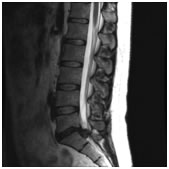
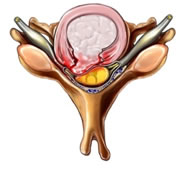
 When a spinal nerve is compressed it causes a characteristic type of pain. It is often quite severe and usually dependent on position. The distribution and character of the pain can help determine which nerve is being compressed. For those patients, not responding well to rest and medications, surgical decompression of the affected nerve is highly effective in treating the pain. Up to 90% of carefully selected cases will receive total or near total relief.
When a spinal nerve is compressed it causes a characteristic type of pain. It is often quite severe and usually dependent on position. The distribution and character of the pain can help determine which nerve is being compressed. For those patients, not responding well to rest and medications, surgical decompression of the affected nerve is highly effective in treating the pain. Up to 90% of carefully selected cases will receive total or near total relief.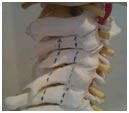
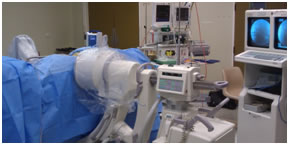
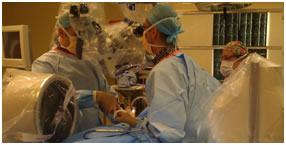
 A fusion is designed to join two or more segments together permanently. It is indicated when the intervening disc is the source of back pain or if there is obvious instability or movement across the level. The most common way this is done initially is with Titanium Pedicle screws, fixed with rods and caps. At the time of surgery, bone graft and supplements will be placed to enable a bony fusion. In time, this will provide the strength of the fusion. Alignment and curvatures can also be corrected with instrumented fusions.
A fusion is designed to join two or more segments together permanently. It is indicated when the intervening disc is the source of back pain or if there is obvious instability or movement across the level. The most common way this is done initially is with Titanium Pedicle screws, fixed with rods and caps. At the time of surgery, bone graft and supplements will be placed to enable a bony fusion. In time, this will provide the strength of the fusion. Alignment and curvatures can also be corrected with instrumented fusions.